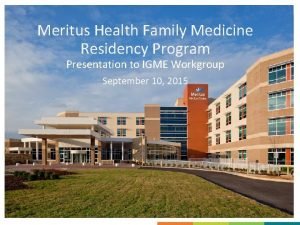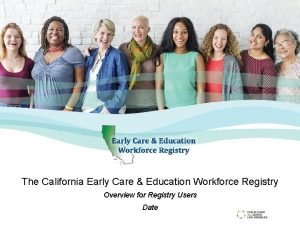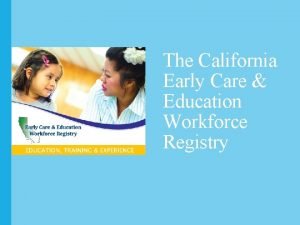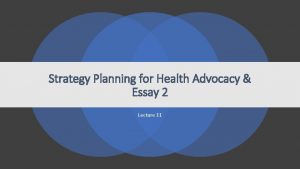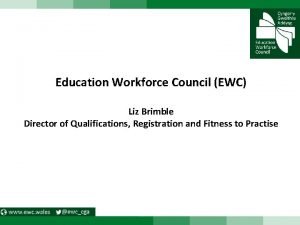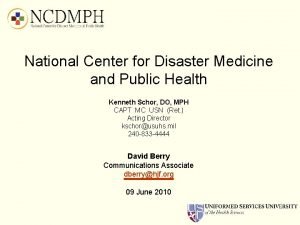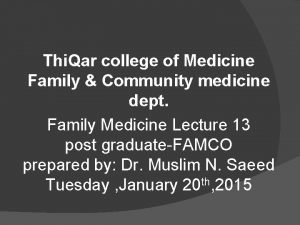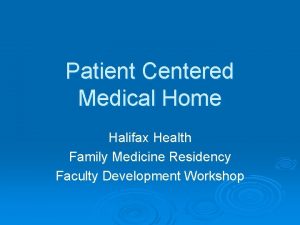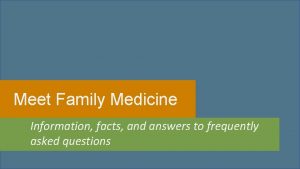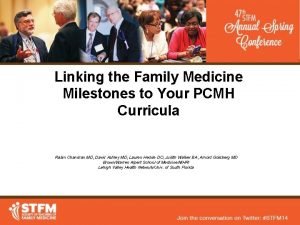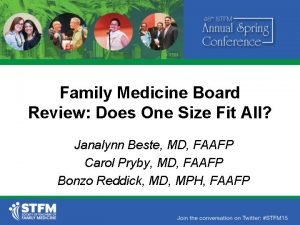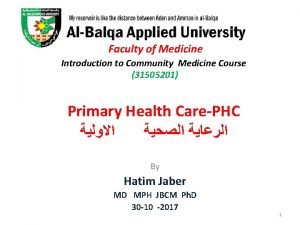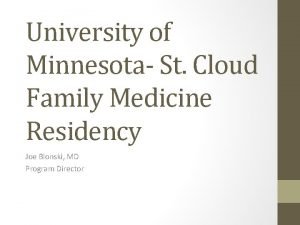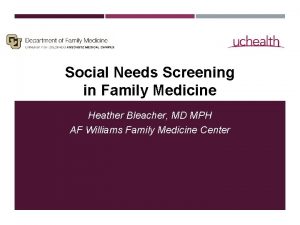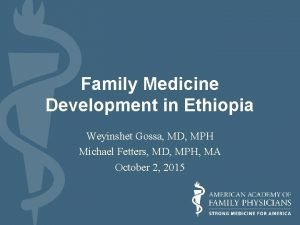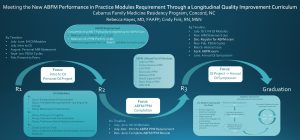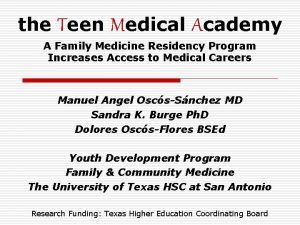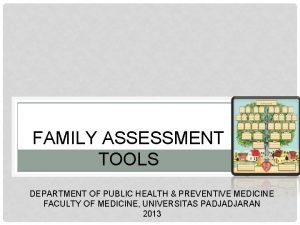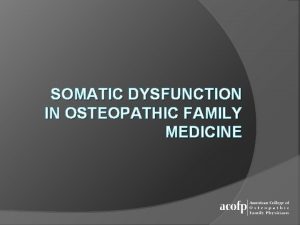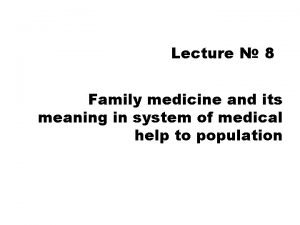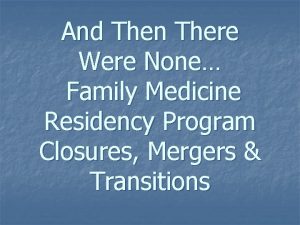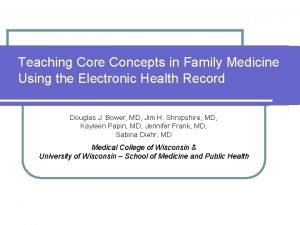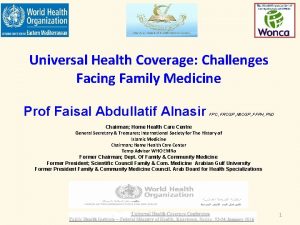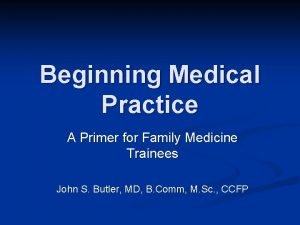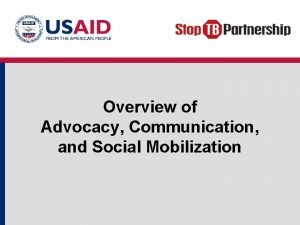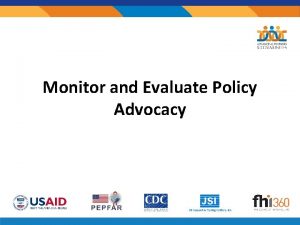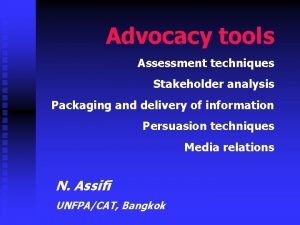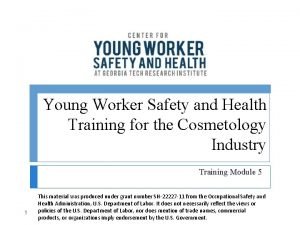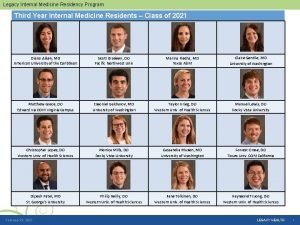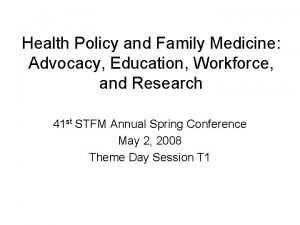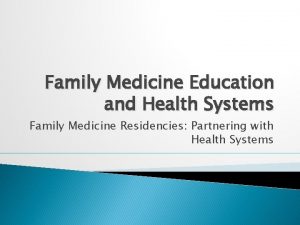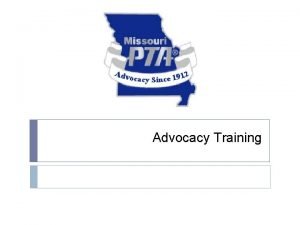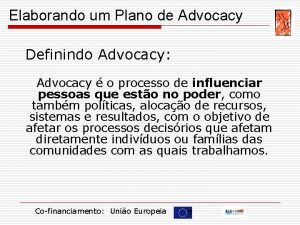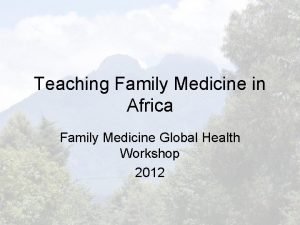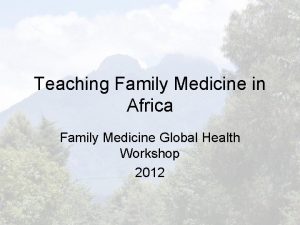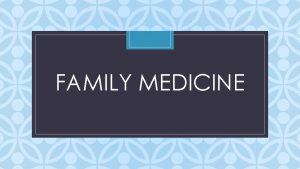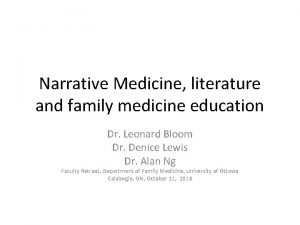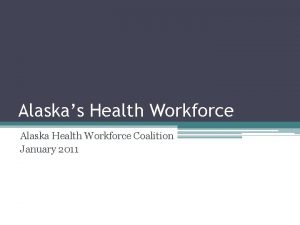Health Policy and Family Medicine Advocacy Education Workforce


























































- Slides: 58

Health Policy and Family Medicine: Advocacy, Education, Workforce, and Research 41 st STFM Annual Spring Conference May 2, 2008 Theme Day Session T 1

Presenters • • Eric Henley, MD, MPH Margaret Kirkegaard, MD, MPH Bruce Goldberg, MD Russ Robertson, MD Ron Labuguen, MD Valerie Reese, MD Patricia Gotsch, MD

Format of Today’s Session • Seminar (90 minutes) – State health policy – Medical home model – Family Medicine educators’ roles as advocates and advocacy educators • Lecture-Discussion #1 (45 minutes) – Council on Graduate Medical Education (COGME) – Primary care workforce – Place of the medical home in national discussions • Lecture-Discussion #2 (45 minutes) – How research can best inform health policy development

Format of Today’s Seminar • Health Care Reform Efforts and the Role of Family Medicine in Policy Development (40 minutes) – Texas, California, Illinois, Pennsylvania • Small Group Discussions (25 minutes) – Curriculum development, Faculty development, Public Advocacy • Large Group Discussion (20 minutes) • Conclusions

Objectives • At the end of this seminar, attendees will be able to – Describe health reform policies in four states (Texas, California, Illinois, and Pennsylvania) that address access to care and the role of the medical home – Discuss the role of family medicine educators as advocates and developers of advocacy curricula – Identify common attributes of successful advocacy and policy development by comparing these four states and examples presented by attendees

Texas: A Broken Health System Valerie F. Reese, MD

The Numbers • Texas has the highest percentage of uninsured people in the United States. (25%) • 5. 6 million Texans have no insurance • 5 counties account for close to half of the uninsured in Texas (these counties include Houston, Dallas, Fort Worth, El Paso, and San Antonio)

The Economics • 79% of uninsured Texans are employed either full or part time • Small businesses (<50 employees) constitute 73% of all businesses in Texas. Only 37% of these businesses offer insurance. • 53% of uninsured Texans work in construction, manufacturing, wholesale and retail trade.

Advocacy Efforts • The Primary Care Coalition (TPS, TAFP, TSIM) published 2 reports on the state of the health care system in Texas-“Fractured” and “Fading Away: Access to Primary Care” • Both reports are descriptive and have some recommendations but no concrete action items for members

Fading Away • The one concrete item that came out of the work of the PCC was the enactment of tort reform by the 78 th Texas legislature. • Tort reform has seemed to decrease the stream of providers leaving Texas but has not address the continued lack of access and coverage for Texans

Texas Business • The Texas business community has been very involved in discussions surrounding the problems in the Texas health care system. • In 2006, the Texas Business Association published “Employers and Health Care: Crisis and Solutions”

Code Red Task Force that includes: • large Texas employers • representatives of each of the Texas medical school systems (UT, TX Tech, Texas AM) • county health districts • TX Med Assoc • TX Hospital Assoc • faith-based organizations • other interested individuals and groups

Code Red Initially 10 recommendations including: • suggestions for fees • graduate medical education • increasing community health • strengthening public health systems • changing county health system funding • integrated school health programs • encourage health care delivery system innovation

What Have These Efforts Produced? • HB 109 -restores CHIP funding to 2003 levels • SB 10 -provides for 3 -share/multi-share programs; expands Medicaid’s Health Insurance Premium Program • SB 1254&HB 2548 -expands eligibility for Texas’ Health Insurance Risk Pool • With these laws, over 300, 000 Texans will have access to healthcare coverage

What Next? • Texas has a bi-annual legislative process • 2008 will be a time for groups to get their arguments and data together for the next session in 2009. • There are still 5. 3 million Texans without insurance • Speciality groups and physicians need to get involved

Health Care Reform in California Ronald H. Labuguen, M. D.

Focus on Health Care Reform • October 2006: Governor made health care reform a major focus of 2007 -2008 legislative session • California government factoids: – Biennial legislative sessions – Two-house legislature: Assembly and Senate – Governor can call special legislative sessions – Fiscal Year July 1 - June 30

Proposals – Winter/Spring 2007 • Gov. Arnold Schwarzenegger – Employer “pay-or-play” mandate, state-run insurance pool, universal coverage, higher medical loss ratio • Sen. Don Perata (Senate President pro tem)–SB 48 – Individual and employer mandates • Asm. Fabian Nuñez (Assembly Speaker)–AB 8 – Employer mandate, expand subsidized coverage • Sen. Sheila Kuehl (Chair, Senate Health Comm. )–SB 840 – State-run single payer system – Legislature passed similar proposal in 2006 but Governor vetoed • Republicans – Market incentives

Advantages/Concerns • Advantages: – New attention focused on health care – Increase in Medi-Cal payment rates under some plans • Concerns: – Large number of uninsured (6. 5 million) and Medi. Californians – Capacity of current health care system to absorb newly insured patients • Facilities, workforce pipeline – 2% levy on gross payments to physicians (Governor’s proposal), later dropped – Effect of employer mandates, especially on small businesses

Special Session – Fall 2007 • Republican proposals died in committee • Kuehl’s single payer proposal passed Senate but was later dropped • Perata and Nuñez proposals passed Senate and were later merged • Eventually Governor and Perata/Nuñez proposals merged into single bill: “Health Care Security and Cost Reduction Act” (AB 1 X 1) – Health insurance required for most Californians; health plans required to offer coverage to everyone – State-subsidized insurance with sliding-scale premiums – Expanded Medi-Cal eligibility and increased Medi-Cal payments to physicians and hospitals

Health Care Reform Derailed • December 17, 2007: AB 1 X 1 passed in the Assembly 46 -31 • Bad news: State budget shortfall of $14+ billion – Perata asked for cost estimate from LAO: roughly equal to the estimated cost of implementing AB 1 X 1 – Perata withdrew support--concerned about higherthan-expected premiums vs. deficits • January 28, 2008: AB 1 X 1 died in Senate Committee on Health 7 -1 (Chair = Sen. Kuehl)

What’s Next? • Governor and public still interested in health care reform • Possible ballot initiatives (“Propositions”) – If enough signatures obtained by petition, referendum placed on state ballot to adopt legislation • Medi-Cal rate cuts: 10% starting July 1 • Privatization of health centers – Los Angeles

Healthy San Francisco • Health access program for uninsured residents • Employer mandate – Being challenged in court • Medical home • Cost sharing for patients earning 100%+ of federal poverty line – Copayments, quarterly premiums • Concerns – Facilities, workforce, budget, fairness of cost-sharing

Family Physician Advocacy • California AFP sought involvement early in process – “Primary Care Coalition” “Cognitive Coalition” – Meetings with key players (Governor, legislators), testimony at legislative hearings, grassroots advocacy – “Strong Medicine for California” publication – Congress of Delegates separated from Annual Scientific Assembly, meets in Sacramento • Legislative advocacy and media training, legislative visits

Advocacy in Family Medicine Residency Programs • Voter registration drive • “Advocacy Day” • Advocacy training for residents through California AFP – Media training – Legislative advocacy

Healthcare Reform in Illinois Margaret Kirkegaard, MD, MPH


All Kids • First state to offer insurance to “all kids” without access to affordable insurance • Expansion of SCHIP and Medicaid eligibility • Includes all kids regardless of immigration status, income or medical conditions • Different premium levels and co-pays for various income levels up to $160, 000 per family • Vigorously supported by ICAAP, Endorsed by IAFP

All Kids Continued • Initially projected to cover 235, 000 uninsured children in Illinois • After 6 months of enrollment, 75% of all new applicants were already eligible for Medicaid or SCHIP • Proposed funding ($56 million) through implementation of Primary Care Case Management and Disease Management programs


Proposal for Illinois Covered • 1. 4 million uninsured adults in Illinois • Original proposal called for 3% GRT on all businesses with revenue greater than 2 million • 3% employer assessment for business with more than 10 employees • Vigorously opposed by Illinois State Medical Society • Rejected by the legislature

Illinois Covered continued • Governor used executive authority to cut $500 million out of the state budget for healthcare • Attempted to expand Medicaid to 400% of poverty level through emergency rules procedure • Rejected by Joint Commission on Administrative Rules • Governor proceeded in enrolling new families calling JCAR “advisory” • Prompted ongoing lawsuit

Medical Homes for All • All Kids legislation also introduced Disease Management Program and Primary Care Case Management Program • DM targets 230, 000 pts with chronic diseases, “frequent flyers”, institutionalized, asthma • PCCM: “Illinois Health Connect”, 75% of all clients either choose or assigned to a “medical home” (not currently enforced), includes PMPM

Response of Illinois AFP • Endorsed All Kids • Endorsed Illinois Covered but rejected the GRT proposal • Has worked with DM program to provide CME • Has worked with PCCM program to promote education and awareness

Implications for Teaching • Most Primary Care residencies enrolled as “Medical Homes” • Controversial and contentious reform process makes advocacy difficult

Pennsylvania Valerie Gotsch, MD

Pennsylvania: The Problem • • 8% of Pennsylvanians are uninsured 767, 000 adults; 133, 000 children 71% of these are employed Between 2000 and 2006, premiums have increased 75. 6%; inflation 17%; median wages 13. 3%

Prescription for Pennsylvania is a set of integrated practical strategies for improving the health care of all Pennsylvanians, making the health care system more efficient and containing its cost. Right State | Right Plan | Right Now

Affordability • CAP (Cover All Pennsylvanians): subsidized by the state and offered through private insurers; for eligible small businesses and the uninsured • Not-for-profits must provide “community benefit” • Capital expenditures • Decreasing inappropriate ER use • Requiring health care coverage for students • Fair admission and billing practices

Access • Expanding practice • Increasing access on capabilities for weekends and in the midlevel practitioners evening • Increasing access in • Increasing diversity of primary care shortage the provider workforce areas by providing startup funding for FQHCs; workforce development; financial incentives for underserved areas

Quality • Decreasing hospital acquired infections, medical errors, and unnecessary care • Pay for performance systems • Improve care of chronic disease esp. asthma, diabetes, heart disease, lung disease • • Co-occurring disorders Palliative care Pain management Improving long term living options; providing more home/community options • Long term insurance • Wellness promotion

Examples: Bills in Process • House Bill 1093: Medical school loan forgiveness bill • House Bill 2098: Preventable Serious Adverse Events Act • Senate Bill 246: Smoking Ban

Example: Executive Order • May 2007: Executive Order established the Chronic Care Management, Reimbursement, and Cost Containment Commission • Strategic Plan issued February 2008 • Adopting a “chronic care model” patterned after programs in place at the VA, and in Vermont and Washington • Initially will target diabetes and asthma

Advocacy in Pennsylvania • PAFP: PAC – formed in 2003 • Pennsylvania Medical Society: PAMPACPA Medical Political Action Committee • PA Medical Society – April 8: Advocacy Day • Website/links

PAFP • Medical Home Project – aimed at transitioning young adults with special healthcare needs into Family Medicine medical homes • 17 practices statewide are involved in this demonstration project

Thank You!

Small Group Discussions • Divide into three small groups to discuss the following (25 minutes) – Group A: Curriculum Development – Group B: Faculty Development – Group C: Public Advocacy • Each group selects a reporter to report back to the large group (20 minutes)

Group A: Curriculum Development • What curriculum objectives are appropriate to prepare residents for an active role in the development of state health policy? • What methods can be used to teach residents the skills, knowledge and attitudes to become effective advocates?

Group A: Curriculum Development Small Group notes: • Advocacy Day • How? – – Share stories (“case”) of patients’ needs Health Policy e-mail group Make part of “SBP&I” curriculum Lecture? on history of health care coverage & emergence of current mess – Bring in advocate – Weave into “pipeline” lecture/curriculum • • • Role of medical societies in advocacy “Structured debate” Community medicine rotation Ask State Academy to come to teach Write “letter to editor”

Group B: Faculty Development • How well prepared are Family Medicine educators to teach about health advocacy and policy development? • What strategies can be employed to prepare Family Medicine educators for this role? • What resources are available to assist faculty with this challenge?

Group B: Faculty Development Small Group notes: • Texas: Leadership Development conferences – Legislative update – Legislative Liaison • AAFP/STFM Legislative Conference in DC ~May -June • WWAMI Legislative Network • University (Public Health/Public Policy Schools faculty) • State FP academies • Other coalitions that are successfully advocating

Group C: Public Advocacy • Do family physicians have a role in educating patients (potential voters) about state health policy proposals? • How can the public be educated about the value of primary care and a medical home? • What skills are necessary to be an effective community advocate? • What community partnerships should be pursued to effect health policy change?

Group C: Public Advocacy Small Group notes: • Guiding principles shared by FP’s w/ different payor mixes/patient populations served • Interests of FP’s = Health of the Public? • Decreased (Credibility) – – • As a group Personal interests When to act: – Timing • – • Letters to the Editor etc. Sharing stories Patients (voters) – inform key movers Be an “expert” Media increase publicity –share stories – • • “Sharing the costs” of reform Influence of media – – • • • Conducive environment Know key writers/reporters, letters to the editor Legislators/Administrators Partner with organizations –shared vision – Students

Group A: Curriculum Development • What curriculum objectives are appropriate to prepare residents for an active role in the development of state health policy? • What methods can be used to teach residents the skills, knowledge and attitudes to become effective advocates? Group B: Faculty Development • How well prepared are Family Medicine educators to teach about health advocacy and policy development? • What strategies can be employed to prepare Family Medicine educators for this role? • What resources are available to assist faculty with this challenge? Group C: Public Advocacy • Do family physicians have a role in educating patients (potential voters) about state health policy proposals? • How can the public be educated about the value of primary care and a medical home? • What skills are necessary to be an effective community advocate? • What community partnerships should be pursued to effect health policy change?

Large Group Discussion Group A: Curriculum Development Group B: Faculty Development Group C: Public Advocacy



Resources (see handout)
 Duke medicine grand rounds
Duke medicine grand rounds What is policy advocacy
What is policy advocacy Meritus family practice
Meritus family practice Early care and education workforce registry
Early care and education workforce registry Early care education workforce registry
Early care education workforce registry Health advocacy essay
Health advocacy essay Hfle curriculum trinidad
Hfle curriculum trinidad Difference between health education and promotion
Difference between health education and promotion Difference between health education and health propaganda
Difference between health education and health propaganda Education workforce council
Education workforce council Education workforce council
Education workforce council School of public health and preventive medicine monash
School of public health and preventive medicine monash Faculty of medicine nursing and health sciences
Faculty of medicine nursing and health sciences National center for disaster medicine and public health
National center for disaster medicine and public health Faculty of medicine dentistry and health sciences
Faculty of medicine dentistry and health sciences Types of family in community medicine
Types of family in community medicine Principles of family medicine
Principles of family medicine Halifax family medicine residency
Halifax family medicine residency Family medicine fellowship
Family medicine fellowship Milestones family medicine
Milestones family medicine Family medicine boards review
Family medicine boards review Types of family in community medicine
Types of family in community medicine Define family practice
Define family practice Nbme shelf exam percentiles 2021
Nbme shelf exam percentiles 2021 Family ecomap example
Family ecomap example Unfunded residency positions
Unfunded residency positions Af williams clinic
Af williams clinic Kaiser san diego family medicine residency
Kaiser san diego family medicine residency Family medicine in ethiopia
Family medicine in ethiopia Cabarrus family medicine concord
Cabarrus family medicine concord Uthscsa internal medicine residents
Uthscsa internal medicine residents St louis university family medicine residency
St louis university family medicine residency Family apgar
Family apgar Dr riaz qureshi
Dr riaz qureshi Isu family medicine
Isu family medicine Somatic dysfunction in osteopathic family medicine
Somatic dysfunction in osteopathic family medicine Family medicine meaning
Family medicine meaning Margaret wiedmann md
Margaret wiedmann md Screem res scoring
Screem res scoring Principle of family medicine
Principle of family medicine Challenges facing family medicine
Challenges facing family medicine Fee for service vs capitation pros and cons
Fee for service vs capitation pros and cons Categories in research
Categories in research Advocacy goals and objectives examples
Advocacy goals and objectives examples Advocacy communication and social mobilization
Advocacy communication and social mobilization Monitoring and evaluation in advocacy
Monitoring and evaluation in advocacy Assessment tools for advocacy
Assessment tools for advocacy Jonathan sanders lsu
Jonathan sanders lsu National policy and legislation related to child health
National policy and legislation related to child health Mental health policy, plans and programmes michelle funk
Mental health policy, plans and programmes michelle funk Safety and health policy example
Safety and health policy example Ecology of human performance model
Ecology of human performance model Legacy internal medicine residency
Legacy internal medicine residency Conjugal family
Conjugal family Kanbar center
Kanbar center Importance of advocacy in community
Importance of advocacy in community Self advocacy worksheets
Self advocacy worksheets What is self esteem
What is self esteem Positive advocacy
Positive advocacy


